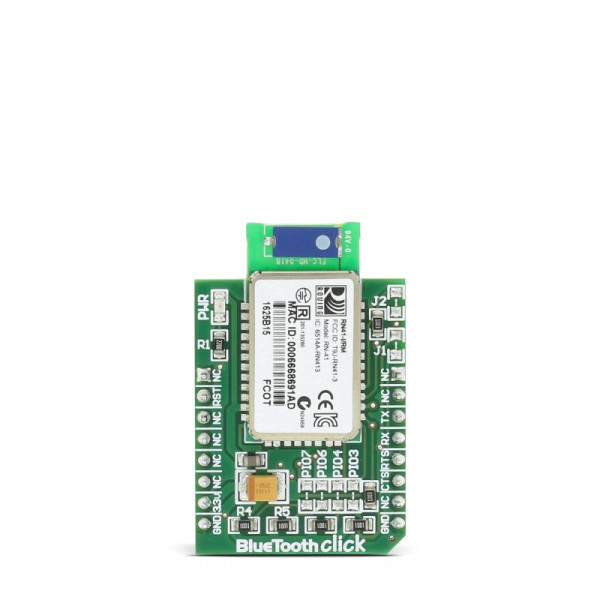- Order number: MIKROE-958
- Manufacturer product ID: MIKROE-958
With the range up to a 100m and low power consumption, Bluetooth click is a great solution if you are looking for a simple way to integrate Bluetooth 2.1 communication to your device. It features the RN-41 low power, class 1 Bluetooth radio module. Bluetooth click communicates with the target board MCU through UART interface and is designed to run on 3.3V power supply only.
RN-41 module
The RN-41 Class 1 Bluetooth radio module delivers up to a 3-Mbps data rate, for distances up to 100 meters (class 1 radio).
Bluetooth 2.1
Bluetooth 2.1 + EDR version includes sniff subrating, a feature that significantly increases battery life for devices that have long periods in idle mode, like home sensor networks, headsets, etc. The host can specify maximum transmit and receive latencies, so that a device knows how often in a cycle it needs to enter sniff mode.
Power consumption
The average power consumption in normal mode is 30mA, 8mA in low-power sniff mode, and only 2.5mAin stand-by mode.
Low power consumption and high data rates make this click the best choice in barcode scanners, measurement and monitoring systems, industrial sensors and controls, medical devices, asset tacking, etc.
Specification
| Type | Bluetooth,BLE |
| Applications | Low power consumption and high data rates make this device the best choice in barcode scanners, mesurement and monitoring systems, industrial sensors and controls, medical devices, asset tacking and more. |
| On-board modules | RN-41 module |
| Key Features | Fully qualified Bluetooth 2.1/2.0/1.2/1.1 module |
| Key Benefits | Low power (30mA connected, less then 10mA sniff mode). UART Data rates up to 3Mbps |
| Interface | UART,GPIO |
| Input Voltage | 3.3V |
| Compatibility | mikroBUS |
| Click board size | M (42.9 x 25.4 mm) |
Key features
- RN-41 module
- Bluetooth® version 2.1 module
- Low power (30 mA connected, <10 mA sniff mode)
- 3-Mbps data rate for distances up to 100 meters
- Interface: UART
- 3.3V power supply
Pinout diagram
This table shows how the pinout on Bluetooth click corresponds to the pinout on the mikroBUS™ socket (the latter shown in the two middle columns).
Programming
The following code snippet shows how to change the default Bluetooth device name.
1 void BT_new name()
2 {
3 do {
4 UART1_Write_Text( "$$$" ); // Enter command mode
5 Delay_ms( 500 );
6 } while ( BT_Get_Response() != BT_CMD );
7 do {
8 UART1_Write_Text( "SN,BlueTooth-Click" ); // Name of the device
9 UART1_Write( 13 ); // CR
10 Delay_ms( 500 );
11 } while ( BT_Get_Response() != BT_AOK );
12 }
Code examples that demonstrate the usage of Bluetooth click with MikroElektronika hardware, written for mikroC, mikroBasic and mikroPascal for ARM, dsPIC and PIC are available on Libstock.









